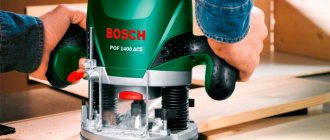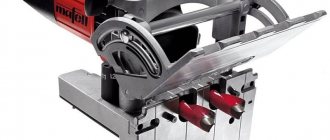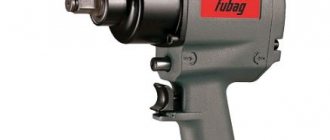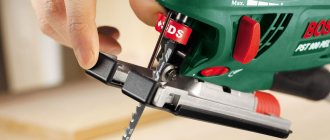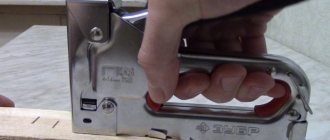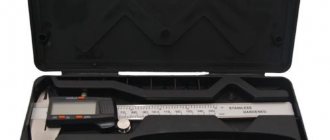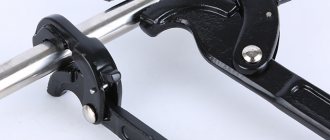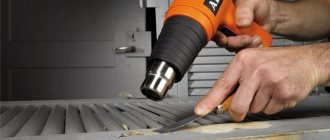A hand router is a universal device that every home craftsman should have in his arsenal. The versatility of this power tool lies not only in the ability to perform various technological operations with its help, but also in the fact that, using the appropriate equipment, you can work with such a router not only on wood, but also on plastic, glass, natural and artificial stone, colored metal. In order for a manual router to effectively cope with all the tasks assigned to it, you should know how to choose the right device, as well as have an idea of its design features, technical characteristics and types of equipment that can be used with it.
It is very easy to get confused in the variety of milling cutter models on the market. Our task is to understand the nuances and make the right choice
Types of hand routers
Plunge router
This tool has a base and two vertical arms. The cutter is directed vertically downwards. When processing, the milling cutter lowers down using pressure, and after finishing it rises back. There is a hole in the base through which the cutter can process the material. This tool allows you to drill holes, process closed contours, and round edges. This type of milling cutter also has names: vertical or rod .
Plunge routers
Edge router
Its body functions as a handle that is held with one hand. At the base of the cutter there is a stop located perpendicularly. Can be used both vertically and horizontally. During use, such a router is pressed against the workpiece with its base and the edge of the wooden part is processed. Used for creating grooves, cutting grooves or chamfering. Its device allows you to perform operations that require high precision. Such milling cutters are also called “ edging router” and “ trimmer ”.
10 options for using an edge router in the workshop
Edge routers
Rotary router
It is made in a narrowed body. This type of tool has a high rotation speed. It is used to create holes and make grooves. It is used not only for working with wood, but also for laminate, tiles, drywall and some other materials.
Using a rotary router, you can perform decorative processing of the material. Such devices are lightweight, which allows the master to spend less effort during the work process. An adjusting screw is provided to determine the milling depth. Some models provide protection against the spread of dust during operation.
Rotary milling machines
Lamellar router
This tool is designed to create grooves of various shapes. It is made in such a way that the body can be held in one hand. There is also a handle for the other hand. There is a stop that is located parallel to the cutter. This tool is used to process the edges of wooden parts. The cross-section of the groove created depends on the shape of the cutter.
Lamellar routers
Filler milling cutter
The main purpose of such a router is to use it to create dowel joints, which are used to connect elements when assembling furniture. They are small wooden tenons and holes for them, made on the corresponding parts for assembly.
Filler milling cutters
Auxiliary devices used at work
Filigree precision during the procedure is achieved by auxiliary devices:
- parallel or side stop - used for milling along the edge of the workpiece, helps to guide the line evenly;
- guide rail - installed at any distance from the edge edge, used for processing along straight lines;
- copy sleeve - duplicates the contours of the template, creates an enlarged copy of the item;
- ruler-compass - necessary for creating radial lines, allows you to create rounded objects.
To keep the cut area clean, a pipe is used to connect to a vacuum cleaner.
Copy sleeve
Types of cutters used
A large number of types of cutters are used for a variety of tasks. Depending on the type of construction, the following options are distinguished:
- Prefabricated cutters are the most common option. Their peculiarity is related to the manufacturing process. First, they make a blank for the base. And then the cutting part of the shank is welded to it. The connection point is a weak point when operating such cutters. This type is used on cheap models of milling cutters.
- The use of replaceable cutters is more reliable compared to prefabricated ones. In this case, the cutting parts are attached to the base with one or more screws. Their advantage is the ability to easily replace the cutting part. This feature makes it easier to sharpen the shank. They are more expensive, but have a longer service life.
- Monolithic cutters are made by processing a blank. They are highly durable. However, their main disadvantage is that sharpening gradually changes the geometry of the edge.
- Set cutters . The blank that is used in them plays the role of an axis. Cutting parts are mounted on it, which can be separated from each other by washers. By changing the set of cutting parts used, you can select cutters for different edge configurations. This variety is commonly used by professional carpenters.
Types of cutters by design
Material for making cutters
When choosing cutters, you need to consider what material they are made of. The most commonly used are the following:
- High Speed Steel (HSS) is well suited for working with soft woods. The cutters are designed for high-speed processing. If used when processing hard material, they can quickly become dull.
- For hard rocks, cutters with carbide tips or made entirely from carbide blanks are intended. They are designated as HM. The cutting edge is made in such cases from tungsten carbide.
It will be most effective to use the most suitable types of cutters for the job.
Important Specifications
Main technical parameters that matter during operation:
- Electric motor power. The powerful milling cutter easily, without overload, performs shallow sampling and copes with deep ones. Costs – higher energy consumption, weight and cost. There are milling cutters on sale with power ranging from 500 W to 2,500 W.
- Speed. The higher the speed, the cleaner the processing. The downside of the advantage is that the higher the speed, the less the rotational force of the cutter, the greater the load on the spindle bearings. The maximum speed of modern milling cutters is from 20,000 rpm to 33,000 rpm.
- Weight . For hand tools, this is important, since it is more difficult to work with a heavy tool. It is less maneuverable and your hands get tired. There are milling cutters on sale weighing from 1.2 kg to 6.5 kg. Weight depends not only on power. High-quality models use expensive, lightweight and durable magnesium-aluminum alloys, while cheaper ones use heavy ferrous metal.
How to choose a manual router
When buying such a router, you need to remember that the tool is purchased for many years, and you need to be very careful in choosing it.
Determining the required power
An important characteristic is the power used. Milling cutters are divided into the following categories:
- Low power. The lightest ones have a power that does not exceed 750 watts. They weigh approximately 1-3 kg.
- Medium power. The power of medium-sized milling machines is in the range of 750-1500 watts. The weight of the tool is 3-5 kg.
- High power. Designed for power 1500-2300 watts. Their weight exceeds 5 kg.
The most powerful tools are preferred by those who will use them regularly. Such a router will be able to cope with any professional tasks in its field of application. However, beginners will find it difficult to use such a device effectively.
When determining the most appropriate category, you need to carefully consider your needs for its use. In this case, you need to take into account:
- the regularity of such work;
- duration of continuous use of the tool;
- using it for processing hardwood.
You need to choose the best option: the tool should be powerful enough to effectively solve the tasks, but not too massive so as not to cause additional difficulties during work.
Accounting for spindle speed
The faster the rotation occurs, the higher the quality of the machined surface. However, when high precision is required for processing, it is better to use a milling cutter with a lower number of revolutions.
Most of these tools have a speed of 20,000-30,000 rpm. For slow ones it is 10,000-20,000 rpm. High-speed routers can have spindle speeds as high as 35,000 rpm.
When choosing a suitable model, it is important to consider the diameter of the cutting part. The larger it is, the lower the rotation speed can be. The cutting edge will have a higher linear speed. If you rotate it very quickly, the wood surface being treated may start to burn. Since speed is related to the diameter of the spindle used, the best option is to use a variable speed router.
It can be performed smoothly or in steps. Typically, manufacturers indicate the optimal speed for operation in the technical data sheet of the device, but in this matter the final decision is made by the master.
Working stroke
The depth to which the tool penetrates into the material being processed is called the cutting stroke. When using a tool, it is sometimes attached to a special table, on the surface of which the part being processed moves. In this case, the working stroke of the cutter will be less by the thickness of the table.
The larger it is, the more diverse the possibilities for using the tool. For instruments belonging to the light category, this size is in the range of 20-50 mm. In professional models of milling cutters, the working stroke is 70-80 mm.
It should be noted that the groove is not cut to its full depth the first time. In this case, there will be too much stress on the tool. The groove is created in several passes. In cases where hardwood is processed, a single approach is made with an even shallower depth. Some tools provide the ability to adjust the depth of immersion. Its accuracy is at least 0.1 mm.
How to use a router. Tips for beginners
Additional tool features
Some types of milling cutters provide additional features that increase work efficiency. Here are some of them:
- Constant electronics can be used. During operation, the spindle speed may slow down. In order to compensate for this, automatic adjustment can be provided to maintain the rotation speed at a constant level.
- In powerful milling cutters, when turned on, there is a sharp jerk. In order to avoid this, some models provide a smooth speed switch.
- During prolonged and continuous operation, overheating of the windings is possible. Overload protection can be used, which measures the temperature and takes certain measures when it exceeds a predetermined level. Actions in such a situation can be different: from turning on the indicator light to temporarily stopping the rotation of the cutter.
The tool must have an additional button to protect against unintentional activation. It must be pressed simultaneously with turning on the device. Otherwise, the tool will not turn on.
Author: RUNSMOR
Scope of application
Hand-held wood routers are a tool in which the cutting element is a milling cutter installed in a collet-type chuck, which, in turn, is placed in a mechanical gearbox driven by an electric motor.
Manual milling cutters are used for:
- drilling holes of any diameter and shape, which depends on the size of the cutters used;
- leveling wooden surfaces, as well as the contours of parts and wooden blanks;
- cutting various grooves, splines and tenons;
- profiling of various types of edges;
- making decorative carvings.
Carving is one of the main functions of hand-held wood routers, and for drilling and leveling, as a rule, special types of hand tools (drills, planes, etc.) are used.
Artistic carving is one of the uses of such a tool
